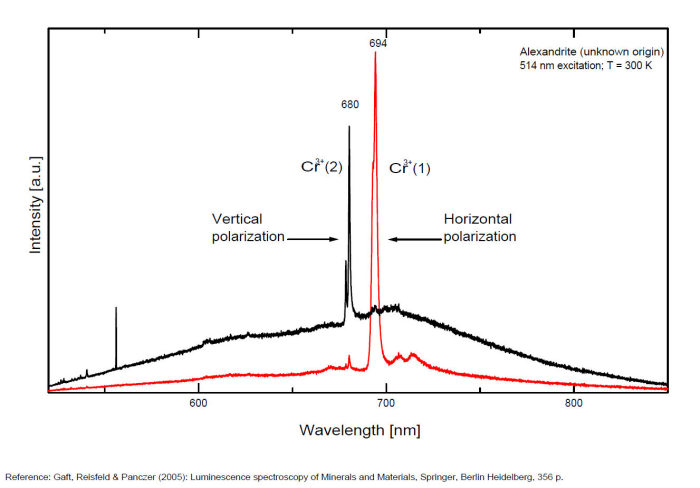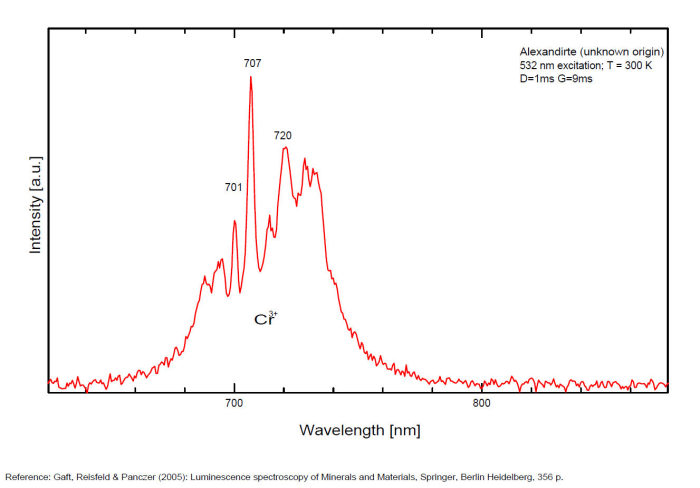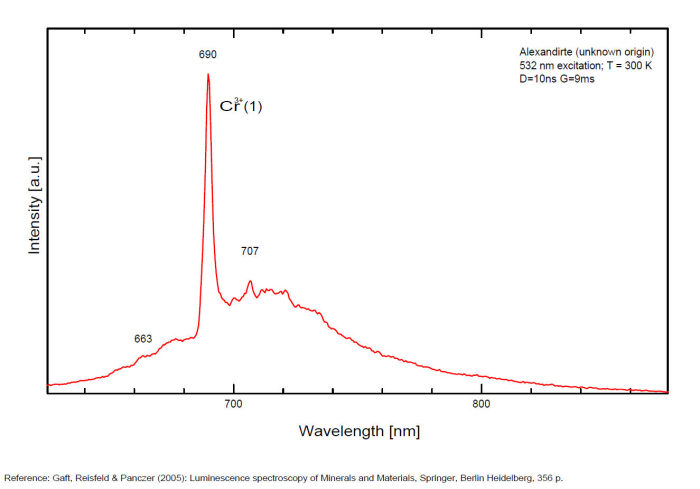Database of luminescent minerals
alexandrite
Chemical formula: See CHRYSOBERYL
Family: Oxides and hydroxides
Status: NON APPR
Crystal system : Orthorhombic
Display mineral: NON
Luminescence:
Longwave UV (365nm) colors: |
Red , Greenish white , | ||
Intensity LW:Weak | |||
Midwave UV (320nm) colors: |
Red , | ||
Shortwave UV (254nm) colors: |
Red , | ||
Intensity SW:Weak | |||
Do you have a photo of this mineral you would like to see in the gallery? Contact us!
Phosphorescence (in the common sense of the term) observable with the naked eye:
No phosphorescence visible to the naked eye under any type of UV
Comments:
CHRYSOBERYL var. alexandrite
Activator(s) and spectrum:
Activator(s): Cr3+, Mn4+, V2+,
Peaks in the spectrum (nm):
663, 664, Cr3+ II : 679, 680nm Cr3+ I : 689, 690, 693, 694nm Cr3+ : 701, 707, 720, 721nm Broad band peaking at +/- 600 V2+ (?) : broad band peaking at +/- 717nm Mn4+ : broad bands around 650 - 670nm

Spectrum: Michael Gaft, Petah Tikva, Israel. Plot: Institute of Mineralogy, University of Vienna, Austria, with permission of the authors.
Spectrum Galery:



 ...
...Comments on spectrum and activators:
Two types of Cr3+ luminescence centers have been found in natural alexandrite, characterized at 300 K by R-lines at approximately 679.0 with 677.3 nm and 694.4 with 691.7 nm, accompanied by very many N-lines of Cr-Cr pairs. Those centers have been identified as connected with substitutions of Al3+ in different structural sites (Tarashchan 1978). (Scalvi et al. 2003; Trindade et al. 2011)
Best localities for fluorescence (*):
- Magara Mine, Manyara Lake, Arusha Region, Tanzania ;
- Izumrudnye Kopi area, Malyshevo, Ekaterinburg, Sverdlovskaya Oblast, Middle Urals, Urals Region, Russia ;
(*)The data are not exhaustive and are limited to a few remarkable localities for fluorescence
Bibliographic reference for luminescence:
- The Henkel Glossary of Fluorescent Minerals, Dr. Gerhard Henkel, Published by the FMS, 1989 ,
- Luminescence Spectroscopy of Minerals and Materials, M. Gaft, R. Reisfeld, G. Panczer, Springer Editor, ISBN: 10 3-540-21918-8 ,
Reference for luminescence on the Internet:
Mineralogical reference on the Internet:
 http://www.mindat.org/show.php?name=Alexandrite
http://www.mindat.org/show.php?name=Alexandrite
 http://webmineral.com/data/Alexandrite.shtml
http://webmineral.com/data/Alexandrite.shtml
Internet Search:
 Image search on 'Google Images'
Image search on 'Google Images'
 Search for documents in all languages on Google
Search for documents in all languages on Google
A request providing no result means only that no such reference exists in the database, but it does not mean that what you are looking for does not exist, just not to our knowledge. If you think you have found an error or omission, please let us know via the contact page being sure to cite the source of information.

